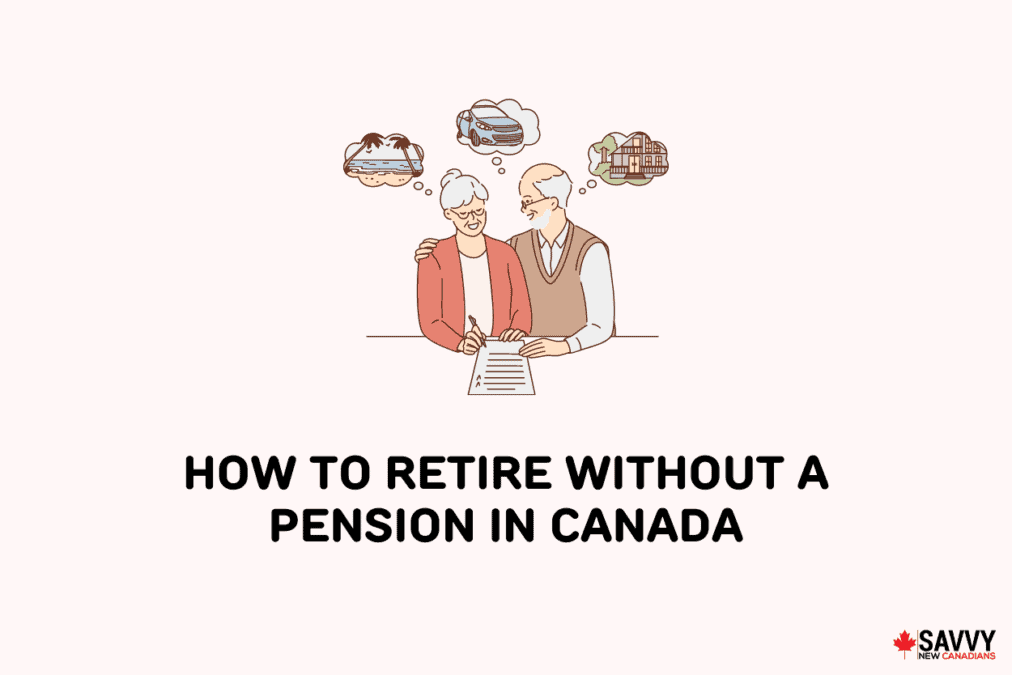If you find yourself worrying about retirement with minimal savings and no access to a gold-plated pension, you are not alone.
Less than 52% of Canadians said they were confident about their retirement plans based on a recent survey conducted by the Canadian Imperial Bank of Commerce.
And only 43% thought they were saving enough.
Retiring comfortably when you have a low income can be challenging, especially based on the notion that you may need $697,000 on average … if you go by the result of a Scotiabank poll.
So, how do you retire without a pension? This post covers various income sources and strategies you can use.
How To Retire in Canada Without a Pension
Canadians are fortunate to have publicly funded pension plans they can fall back on.
While having an employer-sponsored pension, such as a defined benefit or defined contribution pension plan is great, these benefits are no longer as widespread as they used to be.
And if you are a freelance worker, saving and planning for retirement could entirely be in your hands.
Broadly speaking, you could cover shortfalls in your retirement savings using:
- Federal pension benefits and plans: Old Age Security (OAS), Canada Pension Plan (CPP) or Quebec Pension Plan (QPP), and Guaranteed Income Supplement (GIS)
- Private savings through registered investment accounts (Registered Retirement Savings Plan – RRSP and Tax-Free Savings Plan -TFSA) and non-registered accounts
- Provincial seniors’ benefits
There are also various steps you can take to manage limited financial resources in retirement.
Above all, you want to start planning ahead to ensure you are not left stranded without adequate cash in your senior years.
To start, let’s cover the sources of money provided by the federal government.
1. Old Age Security (OAS)
This universal retirement income source is provided to Canadians who are 65 and older.
How much you receive is not dependent on whether you worked or not. Instead, the maximum payment amount is pro-rated based on how long you have lived in Canada after turning 18.
You get the maximum if you have lived in Canada for 40 years or more.
While OAS is paid starting at 65, eligible recipients can delay receiving the pension for up to 5 years for an increased benefit. OAS is indexed quarterly to account for inflation.
Here is the current OAS payment amount and how it is taxed.
2. Guaranteed Income Supplement (GIS)
In addition to the OAS, low-income retirees may qualify for the Guaranteed Income Supplement (GIS), a monthly non-taxable benefit that can exceed OAS pension amounts.
To qualify for GIS, you must be 65 or older, have a low income, and be getting the OAS.
Unlike the OAS pension, this benefit is not taxable.
Also, if you have a spouse or common-law partner, they may qualify for an Allowance benefit.
As of 2023, a single senior with an annual income of less than $20,832 could get GIS. The income thresholds for couples are higher.
3. Canada Pension Plan (CPP)
The Canada Pension Plan or Quebec Pension Plan is one of the key elements of retirement income planning in Canada.
It is designed to replace 33% of your pre-retirement income up to a limit and requires contributions during your working years.
Unlike the OAS, CPP contributions are deducted from your paycheques, and how much you receive is dependent on:
- Your contribution amounts
- How long you contributed to the plan
- Your average earnings, and
- The age you start your pension
The standard age for collecting the CPP retirement pension plan is at age 65.
However, you can also take CPP starting as early as age 60 for a reduced pension or delay until as late as age 70, for a higher benefit.
Here are the pros and cons of taking CPP at age 60.
CPP, QPP, OAS, and GIS may not be sufficient to cover your income needs.
To shore up your savings, consider utilizing tax-advantaged registered accounts like the TFSA and RRSP.
4. Registered Retirement Savings Plan (RRSP)
An RRSP is a savings plan you can contribute to while working and earning income.
Income or investment earnings generated by the account are not taxed, and you only pay taxes when you begin making withdrawals.
Each year, you have a contribution limit that is 18% of your earned income from the previous year up to the maximum threshold ($31,560 in 2024).
The neat thing about contributions to an RRSP is that these contributions lower your taxable income and result in tax savings while you are still earning an income.
An RRSP can be held as a savings account, or you can invest it using Guaranteed Investment Certificates (GICs), stocks, bonds, mutual funds, or Exchange-Traded Funds (ETFs).
You are not required to invest your full RRSP contribution limit each year. Leftover contribution room can be carried forward to future years.
5. Tax-Free Savings Account (TFSA)
Even if you are not working and have no way to generate contribution room via an RRSP, you can save and invest for retirement on a tax-free basis using a TFSA.
A tax-free savings account is available to Canadians over the age of 18. You can contribute up to your total limit each year and carry forward unused contribution room to future years.
Check your CRA MyAccount for details about your contribution room, or call 1-800-267-6999.
Various types of investments are permitted to be held inside a TFSA, including cash or savings, stocks, bonds, mutual funds, ETFs, and GICs.
While income earned in a TFSA is always tax-free, you cannot deduct contributions from your income at tax time.
Learn about how TFSA investments and contributions work.
Some provinces have programs that give money to low-income seniors.
6. Provincial Seniors Benefits
Depending on your province of residence and financial situation, you may qualify for benefits through these programs:
- British Columbia Senior’s Supplement Program
- Alberta Seniors Benefit Program
- Manitoba 55 Plus Program
- Ontario Guaranteed Annual Income System (GAINS)
- New Brunswick Low-Income Seniors Benefit
- Newfoundland and Labrador Senior’s Benefit
- Nunavut Senior Citizen Supplement Benefit
- Saskatchewan Seniors Income Plan
- Northwest Territories Senior Citizen Supplementary Benefit
- Yukon Seniors Income Supplement
You can search for the support available in your province using the Benefits Finder or look at this list.

How To Retire in Canada With Limited Savings
If you are already retired or close to retirement and have limited resources to fall back on, you will need to adjust your spending habits and find ways to cut expenses.
Some steps you can take:
7. Plan For a Frugal Retirement
Let’s face it; most people want to be able to spend at will when retired. Vacation at exotic places, golf all week long, complete a long bucket list, help their kids financially, and more.
If you are hard-pressed for funds, though, you will need to re-organize your goals to avoid running out of money.
This can include travel hacking to save money, growing your food, staying fit to reduce health and medical costs, and picking up inexpensive hobbies.
8. Downsize
This can be a good time to sell a big house and move into a smaller place (house, apartment, or condo) to free up some cash.
Even better, you can use this opportunity to relocate to a cheaper city or town that’s also conducive to retirement.
Declutter and sell things you no longer need.
If you don’t want to sell your home, you could also consider getting a reverse mortgage. A reverse mortgage helps you to benefit from the equity in your home without selling it.
9. Pay Off Debt
High-interest debt can ruin your retirement plans.
If you are carrying high-interest credit card debt, aim to pay it off quickly.
The 20% or so interest rate on credit card debt is much higher than the returns you can expect on your retirement accounts.
10. Delay CPP
Canadians can delay collecting CPP retirement pension until age 70.
For each month you delay past 65, you get a 0.70% increase, for up to a 42% increase at age 70.
If you are still working, have an average life expectancy (or better), or are eligible for GIS, it may make sense to delay CPP and get a higher payment later.
11. Find Part-Time Work
Start a small business or find a part-time job to earn some income.
The interactions you have with others can help you stay mentally sharp, and the extra money will make retirement more comfortable.
What is a Good Retirement Income in Canada?
How much you need to save to retire depends on several factors:
- Expected income from OAS, CPP, and GIS
- Retirement lifestyle planned
- Health situation
- Expenses
- Age at which you retire
- Pre-retirement income
- Where you plan to retire
While a CIBC showed that Canadians estimated $756,000 as the average amount required to retire, your mileage will vary. In fact, a more recent poll by Scotiabank put the average at $697,000.
If you are a newcomer to Canada, your OAS and CPP benefits may be lower. This makes personal savings vehicles like TFSA and RRSP more important.
How To Calculate Retirement Income Needs
There are two easy ways to estimate how much savings you will need:
- 70-80% of pre-retirement income
- 4% withdrawal rule
70-80% of Pre-Retirement Income
If your annual employment income is $60,000, you can estimate that you will need 70-80% of this income in retirement to maintain your current lifestyle, i.e. $42,000 to $48,000.
You can also estimate your expected expenses to arrive at this figure.
4% Withdrawal Rule
With your annual income already determined, you can estimate how big your retirement pot should be to generate this income.
Using the example above, we can divide $42,000 by 4% (0.04) to arrive at just over $1 million. This is a big number, and it is out of reach for most Canadians.
We can drill down into the numbers by looking at how much is already guaranteed through federal pensions (OAS, GIS, and CPP).
Assuming a couple where both spouses get the full OAS pension amount of $707.68/month* ($16,984.32 annually).
*The OAS amount used is for 2023 and assumes OAS eligibility age from 65-74.
For CPP, let’s assume the family’s combined annual CPP benefit is $15,000 (about 50% of the maximum).
Deduct OAS and CPP total of $31,984 from the $42,000 annual income required (i.e. 70% of pre-retirement income), and you have a $10,016 shortfall.
To calculate how much savings you need in your investment/savings accounts based on the 4% rule, we divide the savings gap of $10,016 by 0.04 to arrive at $250,400, a significantly lower amount.
They may not need as much money if they also qualify for some GIS benefits.
Conclusion
You can pull off a comfortable retirement in Canada without an employer-sponsored pension plan.
To do this, plan on maximizing government benefits, start saving as soon as you can, pay off debt, and consider downsizing to cut costs.
You should also find part-time work to supplement your income.
Related:




Excellent comprehensive overview, Enoch!
I am a fan of mapping out current costs and looking at what might be different in retirement to come up with a retirement spending target.
Steve
That makes sense, Steve. Thanks for your feedback!
I’ve been reading your excellent blog for awhile now. Also, I recommend it to my more advanced ESL students too (newcomers to Canada). I am an ESL teacher.
I wonder if you are aware of John Stapleton’s work (https://openpolicyontario.com/)? I went to one of his talks and I’ve also review materials available at his website. (Some of the advice may be specific to residents of Ontario.) He helps those facing low income in their senior years, including people who are surviving somehow on a disability pension.
I will be low income when I retire or semi-retire in 2-5 years.
Unfortunatley, I’m currently carrying quite a burden, by coming to the employer pension plan very late in life. The amount taken from my earnings currently is tough. And I am a single parent with an 18 and 20 year old to help get through post secondary school.
In a few years, I will get such a tiny pension amount when I retire, which will only reduce the amount of GIS that I likely will qualify for. I don’t know if this future government “clawback” will be compensated by having an employer contribution now, while I’m still employed. (Incidentally, this situation has caused me anguish. Once you “sign up” with the pension, you are stuck. Someone from that plan (OMERS) actually told me during an online meeting that I could just quit if I wanted out. I couldn’t believe it. Other unionized education workers who will get a generous pension, after 10, 20 or more years, having earned a higher salary with a FT regular position, JUST DON’T seem to get the difference.)
I also am unclear about the implications of home ownership post-retirement vs. selling and living off some of that capital (with these funds parked in a relatively safe place). My original plan was to remain in my current home or a smaller home, knowing that my home’s value would not considered in calculations to determine OAS and GIS. Now I’m thinking it would be better to not be tied to one address, as my house continues to age along with me.
It’s a long comment. I will be trying once more to get some honest advice from an affordable expert in the next year. (They are usually focussed on more clients with a comfortable amount of wealth to draw on in retirement.
Thanks.
@HAK: I am not very familiar with his work, but a quick search online shows he is an expert in this area. You ask pertinent questions, and I think you would benefit from chatting with a fee-only financial advisor. There are so many moving parts (pension plan, workplace contributions, home ownership, etc.) and it could be invaluable to get an overall assessment of your finances before retiring. Unfortunately, I do not offer one-on-one financial advice and am also not licensed to do so. I hope you can find a competent expert. The only resource I could think of for finding financial planners is this one: https://fpcanada.ca/findaplanner